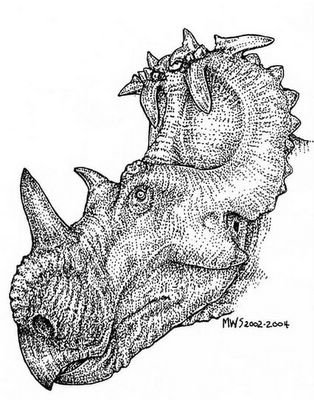
Art © Mark Schultz 2005.
Abstract: Centrosaurus brinkmani (sp. nov) is distinguished from Centrosaurus apertus by key features of its cranial ornamentation, including the shape and orientation of the postorbital horn and parietal ornamentation at parietal locus 3, the shape of the parietal ornamentation at locus 2, and the possession of accessory parietal ossifications developed as short spines on the caudal parietal ramus. This species is restricted to the Oldman Formation of southern Alberta and is the oldest ceratopsid represented by diagnostic material in Canada. Phylogenetic analysis of the Centrosaurinae suggests that the development of spike-like ornamentation at the parietal locus 3 parietal locus is inversely related to the development of the P1 parietal ornamentation.
From the press release:
The new species of dinosaur, named Centrosaurus brinkmani, belongs to the group of dinosaurs related to the well-known Triceratops, but lived about 10 million years earlier. Remains of the dinosaur were discovered in bone beds in southern Alberta, the largest of which is in Dinosaur Provincial Park, a UNESCO World Heritage Site.
Ceratopsian (horned) dinosaurs can be distinguished from one another by the ornamentation on their frills that extend shield-like from the back of their skulls.
Distinctive hooks and “spikelets” on the frill of Centrosaurus brinkmani allowed scientists to identify this dinosaur as a new species.

Art © Michael Skrepnick 2005.
“It looks like someone stuck a bunch of long-spined sea anemones all around the margin of the frill,” Ryan said. “The ornamentation on the frill was probably not used as defensive weaponry -- the clusters of spikes would have been too small,” said co-author Dr. Tony Russell, Professor of Zoology at the University of Calgary.
“The spikes were probably more important in signaling sexual maturity to others in the group,” said Russell. “Centrosaurus may have even used them to push each other around in battles over females just as Bighorn sheep rams do today.”

“These bone beds are good evidence that Centrosaurus brinkmani lived and moved in large herds for at least part of the year,” said Ryan. “Whatever killed them deposited their bodies together, where they decayed and fell apart before they were fossilized. Because all the bones had come apart it took us a couple of years of excavation to recover enough pieces to realize that we had something new.”
 The species is named in honour of Dr. Donald Brinkman(left), a palaeontologist at the Royal Tyrell Museum and long-time colleague of Ryan. “Don’s a superb scientist and has done some of the best and most interesting palaeo-research in Canada, if not the world. But, more importantly he's keenly supported the work of students and has always gone out of his way to help everyone learn more about fossils and palaeontology. It’s a pleasure to be able to tip my field cap to him in this way,” said Ryan.
The species is named in honour of Dr. Donald Brinkman(left), a palaeontologist at the Royal Tyrell Museum and long-time colleague of Ryan. “Don’s a superb scientist and has done some of the best and most interesting palaeo-research in Canada, if not the world. But, more importantly he's keenly supported the work of students and has always gone out of his way to help everyone learn more about fossils and palaeontology. It’s a pleasure to be able to tip my field cap to him in this way,” said Ryan.******************************************************
I should also mention that the new dinosaur is a result of a LOT of hard work put in over many years by many hundreds of people, including staff, volunteers, students, and participants in the Royal Tyrrell Museum’s Field Experience program, and the associated volunteer prep program that ran for many years out of the RTMP field station in DPP.
Special thanks go out to Dr. David Eberth and Mike Getty who kick-started the work in BB 138 that produced the holotype, and to volunteers like Bill McPheeters, Karl Schiemann, Cathy Falls and Don Cretin who did a lot of the prep work. The actual list of people to thank would fill up a couple of these pages, but I have to also give a hardy thanks to Palaeoblog coorespondent, Chad Kerychuk of Digital Dream Machine who did a lot of digital work for the project. And ace prospector & preparator Wendy Sloboda, too! You’re all tops!
PS: If you want to learn more about the process that Mark Schultz went through to produce the above reconstruction of C. brinkmani in their Late Cretaceous environment go HERE and pick up Mark’s excellent new art book, “Various Drawings” where he reproduces a lot of the preproduction sketches for the illustration.
PSS: If you'd like a copy of the paper and you're in Canada you can download a free PDF from the journal's site HERE. Outside of the country there is a fee to download it. Or, you could contact the author for a reprint.